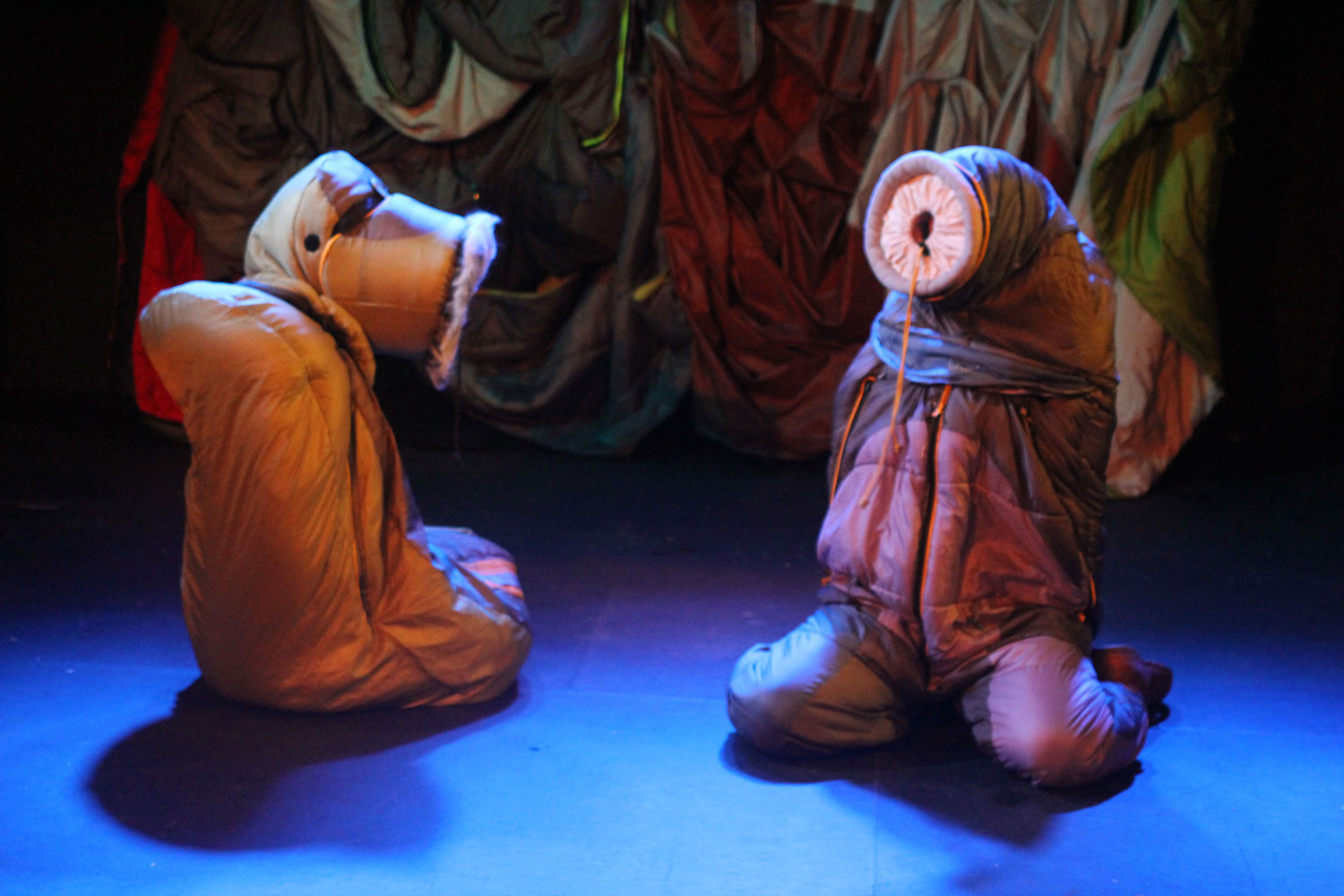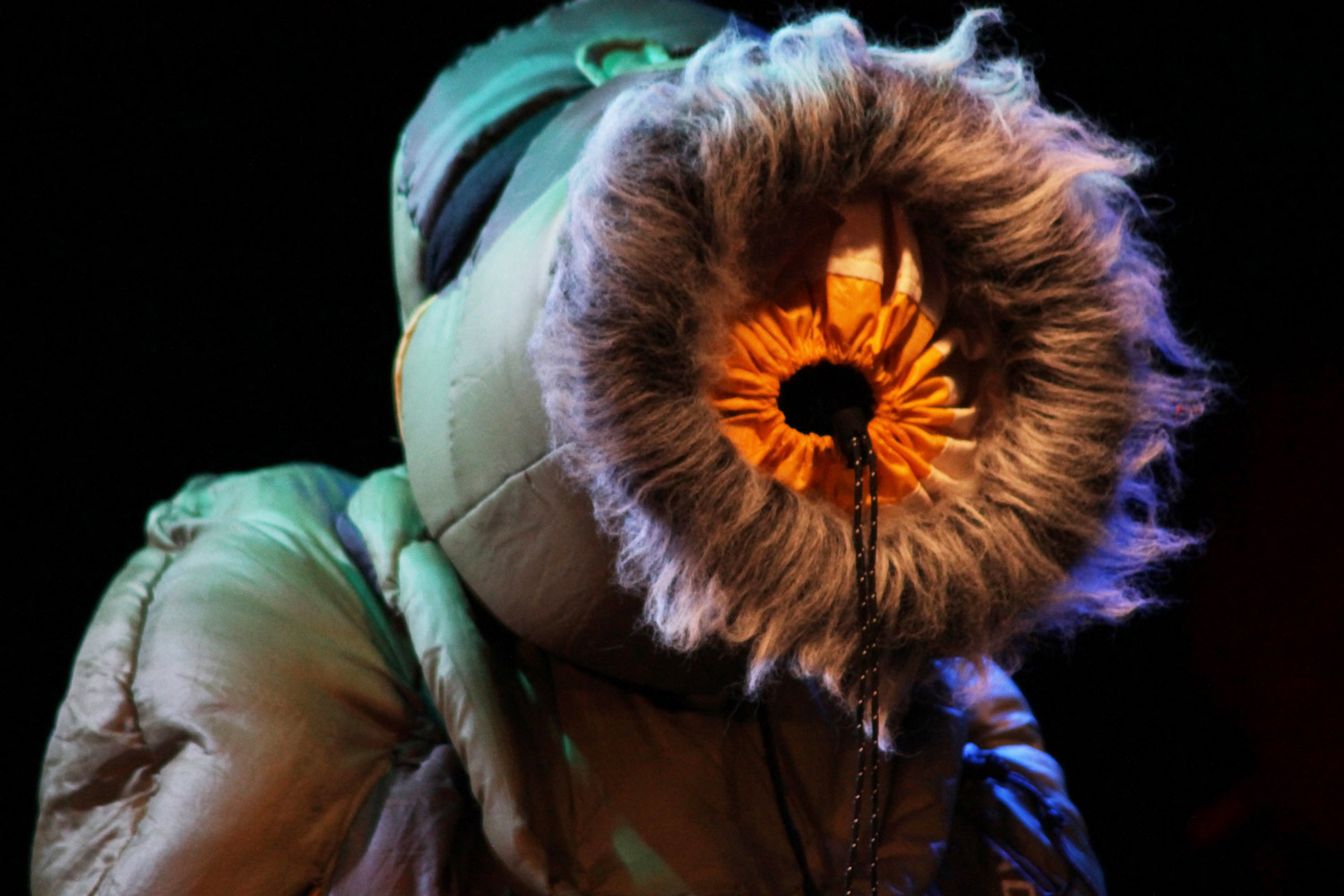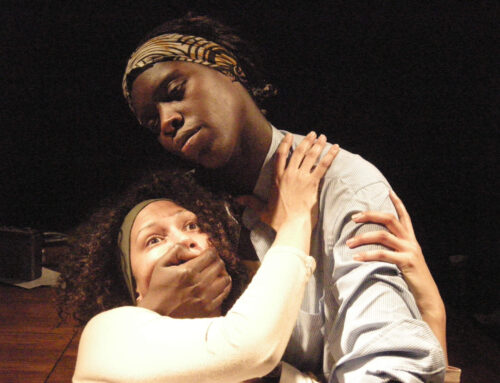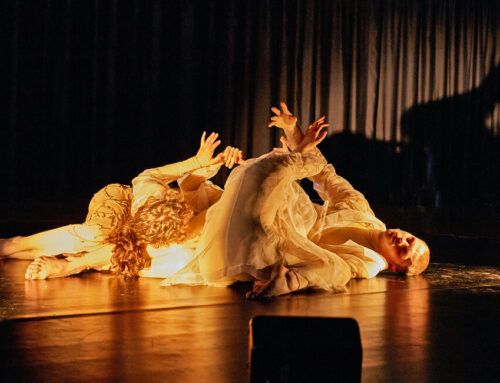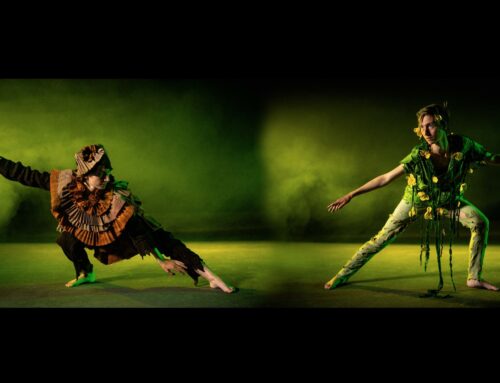Description
What was the case study project about?
Hoax took inspiration from Jules Verne's Journey to the Centre of the Earth the piece evolved into Stuck. Part art-installation, part absurdist theatre, using clown, rhetoric and soft sculpture to examine our cultural paralysis around our changing climate. The all-female cast in the guise of the three Fates, tackle themes of fertility, food access, plastic ingestion and memory displacement in tragicomic attempts at survival, which included making up games to affect the weather. In one scene, a character suckles turgid liquid from ‘camping’ breasts attached to a lifesaver vest. I believe Stuck continues to gain relevance as a courageous and prescient piece of work.
The design, conceived early in the process, tells the story of ecological collapse through a subterranean landscape sculpted from abandoned festival camping equipment. The design presents a symbiotic relationship between body and environment and took inspiration from some of the oldest looking creatures, such as sea cucumbers with a mouth one end to filter food, some with tentacles. This led to conceiving of a sleeping bag metamorphosis in which costumes are envisaged as a series of dramaturgical revelations that morph from unique survival clothing into cocoon-like creatures, ambiguous unsettling early life forms that are, in the final instance, consumed by the set.
In tune with my ecological values, I sourced and repurposed discarded sleeping bags and tents gathered from the cleanup operation at Reading Festival. I used the unique properties of camping equipment in an innovative reuse of materials to give them new life - festival trash is a designer's treasure.
A production image from Stuck was selected for publication in the Aesthetica Art Prize Anthology Future Now 2017. The design was exhibited in the Designers Lead section of the Society of British Theatre Designers (SBTD) exhibition Staging Places at the V&A London 2019-2020.
Eco Thinking
What does ecological thinking mean to you and how do you approach it in your work?
My ecological thinking is rooted in practice - eco-scenography in action. I look for imaginative ways to open up conversations and bring vitality to ecological and social themes. My eco-design remit is to repurpose objects, use surplus/reclaimed materials and commit to a closed-loop design process - 'cradle to cradle' thinking. I hold the vision that all design and productions will be run along sustainable lines.
I incorporate the principles of The 7 R's - refuse, reduce, reuse, recycle, rethink, re-imagine, regenerate into my design process, this is how I creatively flourish in a time of climate change. I embrace 'art as process', whereby the process is visible and the end product is not the only principle or measure of success. I am interested in making work that does not exclude anything as a potential so some of my methodologies are taken from chance and synchronicity. I look for the opportunity rather than the limitations, supported by principles of ecological thinking to guide and enliven my creative vision. My practice is anchored within three core values: - Creativity, Sustainability and Collaboration. By describing myself as an eco-scenographer I make my activism visible.
Stuck, is a culmination of many of my principles and approaches.
Aims and Objectives
What were the aims and objectives of the project?
Hoax began with a provocation - how do we talk about climate change? This objective provided a reference point during the devising process. As part of my response I used the potential within scenography to present an ecosystem at its tipping point, to show the interdependence between body and environment.
In line with this objective, a central tenet of the project was to create the work along sustainable lines, from inception to end of life. Working sustainably included the show’s carbon footprint when on tour. For instance, the set miraculously packs down into three suitcases enabling train travel, this was made possible due to the unique properties of the camping equipment materials. Nylon and polyester are durable, lightweight, crease resistant, and will compact down, proving ideal for sculptural draped forms in the large-scale installation.
Overall, the design contributed to the show's conceptual development and expanded upon its aims and objectives, opening up conversations around sustainability. This versatility proved itself at ONCA’s gallery, Brighton where it was hung as an installation providing a unique environment for Future Fiction Symposium 2018 where I ran a creativity/sustainability workshop with Hoax
Learning Points
What did you do to challenge the status quo?
I incorporated The 7 R's in this production in the following ways, as illustrated below:
Refuse: I refused to buy new which set me off on an adventure to think differently about sourcing materials, and onto a new path to advocacy.
Reduce: Using abandoned materials reduced the carbon footprint of the show; it could also be packed down to enable it to go on public transport. Calculating the carbon footprint for travel often shows it to be one of the biggest areas of impact.
Reuse: The set and costumes were all created from reused camping materials. Other materials were sourced from charity shops.
Recycle: Even the small details, such as the toggles and zips of the sleeping bags were recycled into the design. When the costumes have finished hanging at the V&A the company will consider the next stage in the lifecycle of the set and costumes.
Rethink: In rethinking how the budget was used I was able to save on the materials cost. In this project collecting, sorting and washing the festival equipment so it was ready for repurposing took 6 days and cost £100.
Re-imagine: I went to the cleanup with a concept and a colour palette drawn from nature in mind, to interpret rock formations into sculptural forms and sleeping bags for morphic survival clothing. In the deconstructing of the tents and sleeping bags, the form of the set and costume revealed itself to me.
Regenerate: One unexpected gift from this project was the invitation to share my journey and learning’s with other performance makers and students at various after show talks, colleges, symposia and other events.
Reflection
What are some of the best decisions in relation to ecological motivation and action you’ve made related to this project?
Some of my best decisions working on this project were to do with the process of designing and creating the costumes, which involved play, curiosity and experimentation. Through slowly deconstructing the sleeping bags I noticed how to use existing shapes and details. A personal favourite moment was seeing the potential within a camping chair seat cover to transform into a romper suit. I believe that nothing gives a deeper appreciation of the resources that go into the production of an item than mindfully taking it apart. There is immense personal satisfaction to be gained by re-imagining its new life.
Following on from the show my advocacy has led me to talks at; A Greener Festival, Serious Circus Symposium, PQ19, where I led a round table discussion Role of Theatre Designer for our Time on the SBTD stand. I have been a guest Lecturer at Nottingham Trent University, Arts University Bournemouth and London College of Fashion and in 2020 I was part of a mentoring team for Wild Rumpus’ Sustainability Creation Lab. I enjoy connecting with design students and other designers to share our experiences and exchange top tips about eco-scenography.
Sharing is Caring
What is your advice and best tips for other people and teams who want to bring these values into their work?
Consider how The 7 R’s can be incorporated into the project -cradle to cradle thinking. Anchor practice within core values and principles to use as a checklist, and as the basis of a value statement. Have conversations at the outset of production, sharing is key to demystify sustainably orientated practice. Embrace sustainability, rethink how budgets are distributed and take care of the team. Play and get curious about how things are made. Look for the opportunity, notice and celebrate where things go well and build on it. Share your eco back-story; in theatre programmes, with audiences and peers – become a change maker.
Moving Forwards
How can you be more accountable through your actions as a creative professional?
It has become increasingly evident that the creative sector needs, and is now beginning, to work more along sustainable lines. This was once the remit of smaller scale productions. Employing The 7’Rs can generate savings within budgets and is part of changing the way we think, pointing us in a new direction. To be in sync with sustainable practices however also require an honest, reappraisal of the way we go about creating work and it is easy to overlook hidden labour costs, for instance in this case the collection and preparation of the reclaimed hidden materials took time and effort. Principle 2. Run The Marathon Not The Race - valuing Wellbeing, would have been a useful addition to the planning and execution of this project. There is a long tradition for designers to take on Herculean tasks for little or no extra wages. Speaking personally as a designer, Principle 2 would have helped address this issue and engage with the need for fairer wages, as making work sustainably includes the entire team of people involved in its creation.
I would love to introduce to you the inspirational story of the extraordinary genius Nek Chand, who built the Rock Garden of Chandigarh made entirely from building debris. Nek Chand was a humble transport officer in the north Indian city of Chandigarh, which at the time was under heavy reconstruction and in process of being re-designed by Le Cobusier to become the first planned city in India after The Partition. In the 1960’s Chand began by clearing a little patch of jungle, setting stones around and sculpted a few figures from materials he found. Over the years he recycled tons of broken ceramics and building waste from demolition sites, ferried to the site on his bicycle. After his normal working day Chand worked at night, in total secrecy for fear of being discovered by the authorities. His magic kingdom was nearly destroyed by the government as an illegal structure. However, after an outcry his garden was saved and Nek Chand was given a salary to continue full-time on his work, plus a workforce of fifty labourers. He was also able to set up collection sites around the city for rags and broken ceramics. His devotional work grew into an eighteen acre garden which comprised 2000 statues, waterfalls and amphitheatres, set in a series of interlinking courtyards and is one of India’s most visited sites, second only to the Taj Mahal.



